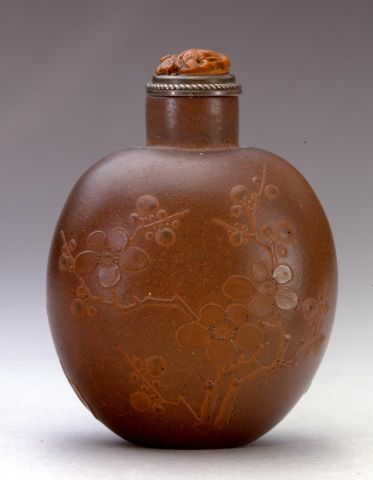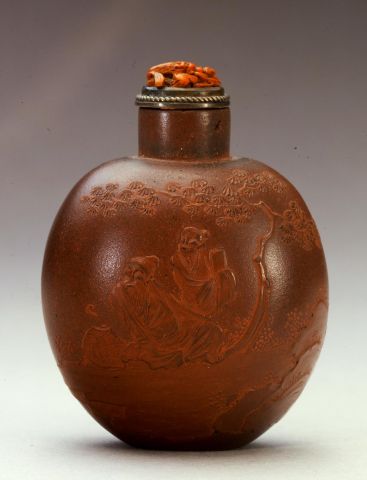

Bottle ID: 368
BROWN WITH BROWN SLIP
Date: 1780-1850
Height: 55 mm
Stoneware, brown, of rounded bulbous form, decorated in low relief using a brown slip of the same color paste, with on one side a seated sage and his attendant beside flowering rockwork and under a gnarled pine tree; the reverse with a flowering prunus branch.
Attributed to Yixing.
Similar Examples:
None found (snuff bottle)
The Art of the Yixing Potter. The K. S. Lo Collection, 1990, p.87, no. 41.
Provenance:
Asian Art Studio
Sotheby’s, New York, September 15th, 1998, lot 205
Neal W. and Frances R. Hunter
Jean Hemphill, 1986
Harold and Dorothy Sooysmith, Portland, Oregon, prior to 1939
Published:
Stevens, Bob C. The Collector’s Book of Snuff Bottles, 1976, p. 100, no. 318
Yixing wares not only appealed to the literati. As early as the Ming Period, the Imperial family ordered pottery from Yixing but the items commissioned were solely dragon basins. Yixing teapots began to appear at the Qing court during the reign of Kangxi, and during the short Yongzheng period purple clay wares which were glazed appeared at Court. Whilst Yixing is fired at 1200 degrees Celsius, the glaze was fired at a lower temperature of 800 degrees. The popularity of glazed wares declined very quickly since the glaze hid the natural texture and patina of unglazed wares. It is debatable whether the Imperial families of the Qing Dynasty commissioned snuff bottles from Yixing. However the K.S. Lo Collection of Yixing wares in the Flagstaff Museum in Hong Kong houses a dated teapot from 1849 of Prince Ding, whose studio name is Zaiquan and who is also the owner of Xingyouheng Tang. Both Prince Ding’s hallmark and studio name are inscribed on the simple enameled teapot together with the date. Prince Ding was known for his simple but elegant taste, and to snuff bottle collectors, as a collector himself with a number of extant inscribed bottles in crystal and jade in today’s collections. Whether or not the present example could have been commissioned by the Imperial family does not matter. Its importance lies in the sheer quality of the slip decoration that is not undermined by its application on to a body of the same color. The resulting bottle is nothing less than the most subtle but powerful work of art that transcends its practical function.
< Back to full list
 English
English 中文
中文